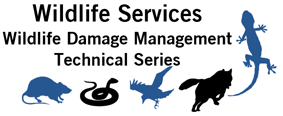U.S. Department of Agriculture: Animal and Plant Health Inspection Service
Date of this Version
2017
Document Type
Article
Citation
DeVault, T.L., B.F. Blackwell, J.L. Belant, and M.J. Begier. 2017. Wildlife at Airports. Wildlife Damage Management Technical Series. USDA, APHIS, WS National Wildlife Research Center. Fort Collins, Colorado. 19p.
Abstract
Collisions between aircraft and wildlife (wildlife strikes) are common occurrences across the developed world. Wildlife strikes are not only numerous, but also costly. Estimates suggest that wildlife strikes cost the civil aviation industry in the U.S. up to $625 million annually, and nearly 500 people have been killed in wildlife strikes worldwide. Most wildlife strikes occur in the airport environment: 72 percent of all strikes occur when the aircraft is ≤500 ft (152 m) above ground level, and 41 percent of strikes occur when the aircraft is on the ground during landing or takeoff. Thus, management efforts to reduce wildlife hazards are focused at the airport. There are many techniques used to reduce wildlife hazards at airports, and these usually work best when used in an integrative fashion. Here, we discuss the available data on wildlife strikes with aircraft, summarize legal considerations, explain why wildlife are attracted to airports and how to identify important wildlife attractants, describe commonly-used tools and techniques for reducing wildlife hazards at airports, and explain how airports can enlist the help of professional wildlife biologists to manage wildlife hazards.
Effective management of wildlife to reduce strikes, like all types of wildlife damage management, is based on principles from wildlife ecology, physiology, and behavior. Airport biologists should consider how these disciplines interact in the airport context, particularly with an understanding of regulatory guidance, non-wildlife related airport safety priorities, and strike data. This “marriage” of wildlife ecology with aspects of airport operations will aid in discerning how and why animals respond to various mitigation methods (at both the individual and population levels), why and under what conditions some management tools and techniques work better than others, and allow airport biologists to more intelligently direct management efforts.
Included in
Behavior and Ethology Commons, Biodiversity Commons, Other Animal Sciences Commons, Other Ecology and Evolutionary Biology Commons, Population Biology Commons, Terrestrial and Aquatic Ecology Commons


Comments
U.S. government work.